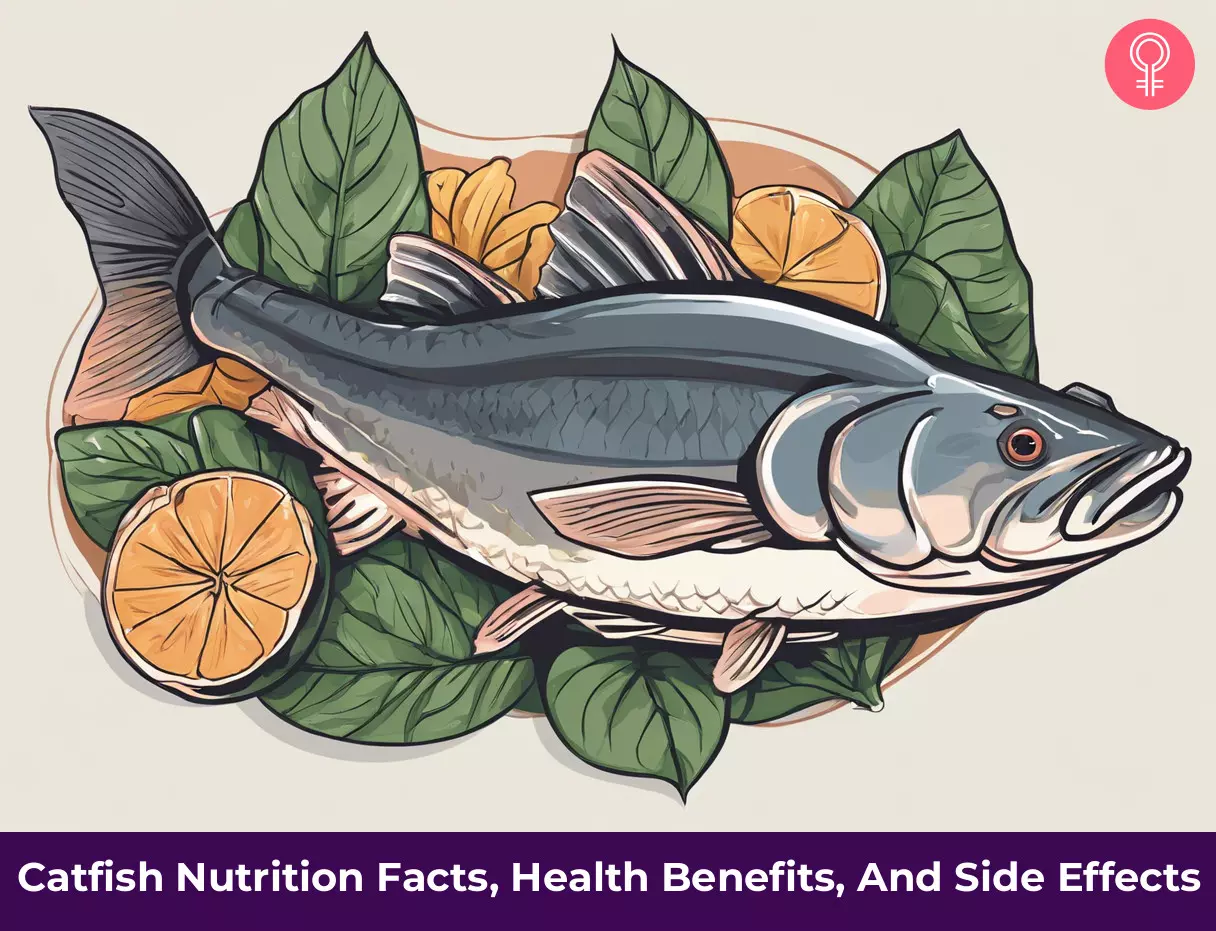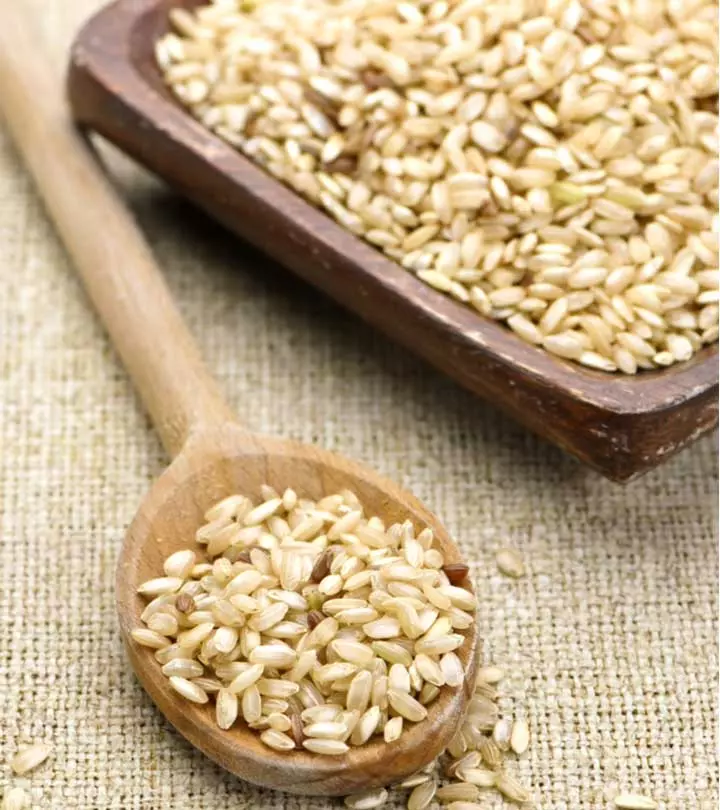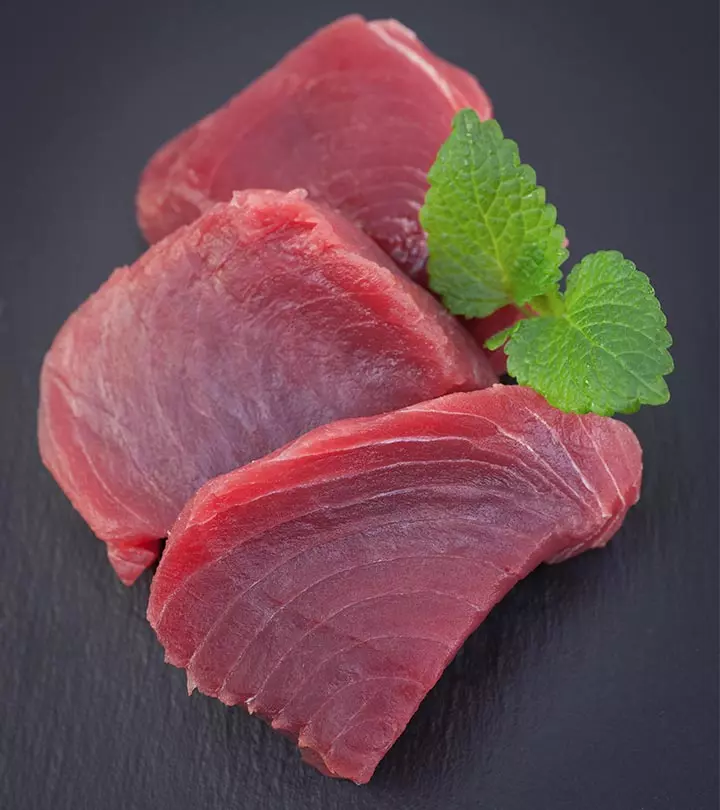Catfish Nutrition Facts, Health Benefits, And Side Effects
If you want to build more muscle, add this delicious fish to your diet right away!

Image: iStock
Catfish (Claria gariepinus) is a freshwater ray-finned fish. It is widely available as farm-raised fish. So, is catfish healthy? Well, high levels of omega-3 fatty acids contribute to the benefits of catfish. This fish has a unique appearance with barbels or whiskers and has naked scales. The omega-3 fats in catfish help promote cardiovascular health. This article explores the health benefits of catfish, its nutrition facts, possible side effects, and the ways you can add it to your diet. Keep reading.
 Know Your Ingredient: Catfish
Know Your Ingredient: CatfishWhat Is It?
A type of freshwater fish.
What Are Its Benefits?
Rich in omega-3 fatty acids, it can improve brain and cardiovascular health, prevent depression, improve muscle strength, and prevent vitamin B12 deficiency.
Who Can Consume It?
Can be safely consumed in moderation by all.
How Often?
Can be consumed daily in small amounts.
Caution
Excess consumption may lead to allergic reactions (rare) such as hives, nausea, vomiting, or digestive disorders. It may also increase the chances of mercury poisoning.
Catfish Nutrition Facts
According to the USDA, a 3.5-ounce (100-gram) serving of fresh catfish provides the following nutrients (1):
Energy | 439 |
Protein | 18.5 g |
Total lipid (fat) | 2.85 g |
Carbohydrate | 0 g |
Fiber, total dietary | 0 g |
Calcium | 11 mg |
Iron | 0.35 mg |
Magnesium | 28 mg |
Phosphorus | 304 mg |
Potassium | 419 mg |
Sodium | 50 mg |
Selenium | 14.3 µg |
Fatty acids, total monounsaturated | 1.1 g |
Fatty acids, total polyunsaturated | 0.636 g |
Besides being low in sodium and calories, catfish is a good source of healthy fats, protein, important vitamins, and minerals.
 Trivia
TriviaGoing ahead, let’s answer the popular question: Is catfish good for you? Read on to know about the various health benefits associated with catfish.
In This Article
Health Benefits Of Catfish
- Contains Health-boosting Omega-3 Fatty Acids
Omega-3 fatty acids are known for their potential role in maintaining cardiovascular health and helping proper brain functioning. Research has suggested regular intake of omega-3 helps improve signs of depression as well (2). A study on 23 individuals reported a 7% decrease in all-cause mortality with a regular consumption increase of 0.2g of omega-3 fatty acids (3). Catfish have white flesh and are relatively lean with a small amount of fat content. Even then, one fillet of catfish can provide you with 253 mg of omega-3 fatty acids (1). While other oily fish varieties might contain higher amounts of omega-3, this still is a reasonable amount to include in your diet. The omega-3 in catfish is in the most bioavailable forms of EPAi Eicosapentaenoic acid; found in seafood that has positive effects on coronary heart disease, high blood pressure, and inflammation. and DHAi Docosahexaenoic acid; found in fatty fish that improves brain health and functioning, high cholesterol, and high blood pressure. , and that means these get easily absorbed by our system.
- Has Minimum Mercury Contamination
Mercury contamination of fish and seafood has recently been of a lot of concern (4). Mercury is known to build up easily in the body and can cause neurotoxicityi The damage that occurs to the nervous system when your brain is exposed to natural or manmade toxic substances like mercury and lead. and developmental issues in children (5). While large variations like swordfish, swai fish, sharks, and tuna are commonly known to have more concentrations of mercury, the catfish fares significantly well in this regard. As per FDA research between 1990-2012, catfish only contain 0.024 PPM (mean average mercury content) (6). Catfish is actually even better than the popular “low-mercury” options in fish like mackerel and herring.
- Dense In Muscle-building Protein
Protein is important for building and maintaining lean muscle mass. It is also a “building block” responsible for the production of enzymes and hormones that affect every function of our body (7). Catfish is extremely protein-dense. 100 grams of catfish can offer you 18.5 grams of protein for only 105 calories (1).
- Rich In Vital B Vitamins
Vitamin B12 is an essential vitamin, and it plays a crucial role in red blood cell formation, brain health, and DNA synthesis
(8). Certain population groups, like pregnant women, infants, and the elderly, are more prone to a B12 deficiency (9). One fillet serving of catfish can provide you with 69% of the daily recommended intake of vitamin B12. Supplementing your diet with catfish can potentially help balance out any deficiencies.
Lami Fearon, a blogger, shared her recipe of catfish pepper soup adding that nothing could cure a hangover faster than a hot and spicy soup. She also writes, “I remember when I was pregnant and suffered morning sickness, I ate whole catfish at least three times a week, the spice helped (i).”
 Fun Fact
Fun Fact- May Improve Heart Health
Catfish is rich in omega-3 fatty acids that may offer significant advantages for heart health. Omega-3 fatty acids help reduce triglyceride levels in the body, which contributes to healthier blood vessels. Additionally, they exhibit anti-inflammatory effects that may lower the risk of atherosclerosis, a condition caused by fat buildup in the artery walls. Thus, the intake of these nutrients may support heart health by maintaining myocardial contractility, which is the ability of the heart muscles to contract. Moreover, these fatty acids may help improve cardiac structure and function. This may help in heart failure prevention and treatment (10). While further research is needed in this regard, the inclusion of catfish in your diet may contribute to these positive health outcomes.
Now that we have seen the various catfish benefits, let’s see if these beneficial nutrients remain the same for both the farmed-raised and the wild catfish.
Key Takeaways
- Catfish is rich in protein and vital B vitamins.
- Although low in calories and sodium, it contains adequate vitamin B12 and omega-3 fatty acids.
- Some popular catfish dishes are lime broiled catfish and cornmeal catfish.
Wild-Caught Vs. Farm-Raised Catfish
Catfish is available all over the world and is commonly found as farm-raised catfish or wild-caught ones. While both these forms of catfish offer us the above health benefits, they have some nutritional differences.
Catfish found in the wild are bottom feeders which means that they survive on algae, aquatic plants, fish eggs, and other fish found at the bottom of their water habitat. Farm-raised catfish on the other hand are fortified with additional feed that’s high in fatty acids, protein, antioxidants, vitamins, minerals, and probiotics (11), (12).
These dietary differences can lead to significant differences in the nutrition value of a farm-raised catfish vs a wildly caught one.
A study comparing the nutrient profiles of wild and farm-raised African catfish found that the wild variety had more protein, fiber, fat, and overall calories than the farm-raised ones (13). Another study on the Indian butter catfish reported that farm-raised fish had higher fat and iron content while the wild fish had higher levels of most other minerals (14).
Having seen the differences between the farmed and wild varieties of catfish, let’s further see how the catfish differs from another commonly consumed fish, the tilapia.
Tilapia Vs Catfish – Basic Differences

Catfish and tilapia are very common fish found and farmed worldwide. You can distinguish tilapia vs catfish from the pointers in the table:
Catfish | Tilapia |
Has a strong fishy flavor | Is milder in taste |
Is richer in omega-3 fatty acids | Has a little amount of omega-3 fatty acids |
Catfish need to be supplemented with Vitamin E | Tilapia has considerably more Vitamin E |
Scaleless, cylindrically shaped body with a flattened underbelly, and characteristic whisker-like barbels. | Laterally compressed, oval body with a long dorsal fin and proportional features, without any distinctly unusual physical features. |
Catfish feed on anything in the water like insects, eggs, larvae, plants, smaller fish, including Tilapia | Tilapia feeds on algae and aquatic plants |
Catfish benefits come from their omega-3 fatty acids and vitamin E content. While the former has more omega-3 fatty acids content, tilapia is richer in vitamin E. When it comes to their flavor, catfish has a strong fishy taste, while tilapia is milder. You can explore tilapia fish benefits if you want to learn more about it.
Now that we know the basic differences of tilapia vs catfish, let’s further understand if there are any side effects of including catfish in your diet.
Possible Side Effects And Allergies Of Catfish

- Contaminants In Catfish
Fish and seafood can easily absorb toxins and harmful trace metals from their habitat waters. Upon eating, these contaminants can move into your system resulting in potential toxicities.
Mercury is one such risky heavy metal that is found in most fish (15). It increases the potential risks of neurodegenerative disorders like Alzheimer’si A progressive condition that harms the brain cells and impairs important brain functions like thinking, memory, and natural behavior. and Autismi A developmental brain condition that impacts the nervous system and impairs cognitive, interactive, physical, and emotional functions. (16), (17). Catfish, with 0.024 ppm (mercury concentration mean) has the lowest mercury concentration amongst most fish making it preferably safer to consume in comparison (6). However, one should be careful of its fishing source and farming methods and avoid excess intake to avoid the possible intoxication from mercury.
- Catfish Allergy
In 2008, catfish production exceeded that of salmon and led a group of scientists to compare the potential allergens (proteins in the fish that bind to human Immunoglobulin E (IgE) antibodies) in catfish and salmon. This particular study conducted on 77 children with fish allergies, reported more IgE-binding allergens in catfish than salmon (18). When you are exposed to potential allergens, your immune system produces IgE antibodies in response. These then release chemicals, causing an allergic reaction.
Though catfish allergies are still not widely heard of, you should avoid excess intake and be careful of any symptoms of an allergic reaction after consumption, skin contact, or inhalation of catfish fumes while cooking.
Talking of cooking, let’s quickly see some of the best cooking methods for catfish.
Best Cooking Methods For Catfish

Frying is a common and traditional method for cooking catfish. However, you can choose to grill, bake or broil the catfish as well to keep the fat intake in check. Let’s see how the different ways of cooking affect the major nutrient intake from a single 3.5oz (100g) serving of catfish (19), (20), (21).
Dry Heat Without Oil | Baked Or Broiled With Oil | Breaded And Fried | |
Calories | 105 | 179 | 229 |
Fat | 2.9 grams | 11 grams | 13.3 grams |
Sodium | 50 mg | 433 mg | 280 mg |
As seen from the above comparison, cooking with dry heat is the healthiest way to prepare catfish. Otherwise, you can opt for monounsaturated or polyunsaturated oils like canola or olive oil and low-sodium seasonings for the healthier preparation of catfish. You can pair the catfish preparation as a side dish with brown rice or couscous, some steamed vegetables, and salad to make it a wholesome nutritious meal. Here are a few recipes for you to try out:
Popular Recipes With Catfish
- Lime Broiled Catfish

Ingredients
- Butter -1 tablespoon
- Lime juice – 2 tablespoons
- Salt (optional) -½ teaspoon
- Pepper – 1/4 teaspoon
- Garlic powder – 1/4 teaspoon
- Catfish fillets (6 ounces each) – 2
- Lime slices or wedges, optional
- Fresh parsley, optional
Instructions
- Melt butter in a small saucepan.
- Stir in the lime juice, pepper, garlic powder, and salt if desired.
- Remove from heat and set aside.
- Place the catfish fillets in a shallow baking pan.
- Brush each fillet generously with the lime-butter sauce.
- Broil for 5-8 minutes or until the fish flakes easily with a fork.
- Remove to a warm serving dish.
- Spoon the pan juices over each fillet.
- Garnish with lime slices and parsley if desired.
- Cornmeal Catfish

Ingredients
- Cornmeal – ¼ cup
- Seafood seasoning – 1 teaspoon
- Catfish fillets (6 ounces each) – 4
- Canola oil – 3 tablespoons
- Tomato (medium, chopped) -1
Instructions
- Take cornmeal and seafood seasoning in a shallow bowl and mix.
- Oat the catfish in the cornmeal mixture and shake off excess.
- Heat oil in a large skillet over medium heat.
- Add the catfish in batches.
- Cook for 4-5 minutes on either side or until the fish flakes easily with a fork.
- Top with chopped tomato and serve.
Infographic: 4 Important Health Benefits Of Catfish
Catfish are widely-consumed freshwater fish that are rich in vitamins, minerals, and omega-3 fatty acids, which may improve cardiovascular health and brain function. We have rounded up 4 vital reasons why catfish should be included in your diet. Check out the infographic below to know more!

Illustration: StyleCraze Design Team
Catfish is a freshwater ray-finned fish found in rivers and lakes that is low in calories. This lean protein source is rich in omega-3 fats, vitamins, and other healthy fats that help treat many ailments. Catfish intake may help improve signs of depression due to its omega-3 fatty acids. It also has minimum mercury contamination and helps maintain lean muscle mass. However, excess intake of catfish may cause allergies. Hence, consume it in moderation to enjoy its maximum benefits. Fish farming and aquaculture that is done keeping sustainability in mind is considered more healthy and environment friendly. So, always make a note of where your catfish is being sourced before consuming it.
Frequently Asked Questions
Is catfish better than salmon?
No. Catfish contains fewer fatty acids when compared to salmon. So from a nutritional standpoint, salmon is the healthier fish to consume.
Is catfish healthier than chicken?
Catfish is healthier than chicken due to the presence of omega-3 fats in it.
Is catfish high in vitamin D?
Yes. One hundred grams of channel catfish contains 500 IU of vitamin D (22).
Discover the health benefits of catfish and see if it is the right choice for you. Learn about its nutritional value and make informed decisions about your diet by watching the video below.
Illustration: Catfish Nutrition Facts Health Benefits And Side Effects

Image: Stable Diffusion/StyleCraze Design Team
Personal Experience: Source
StyleCraze's articles are interwoven with authentic personal narratives that provide depth and resonance to our content. Below are the sources of the personal accounts referenced in this article.
i. Catfish Pepper Souphttps://ajikespecial.wordpress.com/tag/catfish/
References
Articles on StyleCraze are backed by verified information from peer-reviewed and academic research papers, reputed organizations, research institutions, and medical associations to ensure accuracy and relevance. Read our editorial policy to learn more.
- Fish catfish channel wild cooked dry heat
https://fdc.nal.usda.gov/fdc-app.html#/food-details/173714/nutrients - Dietary n-3 PUFA fish consumption and depression: A systematic review and meta-analysis of observational studies
https://pubmed.ncbi.nlm.nih.gov/27544316/ - Fish long chain omega-3 polyunsaturated fatty acids consumption and risk of all-cause mortality: a systematic review and dose-response meta-analysis from 23 independent prospective cohort studies
https://pubmed.ncbi.nlm.nih.gov/28802305/ - Environmental Mercury and Its Toxic Effects
https://www.ncbi.nlm.nih.gov/labs/pmc/articles/PMC3988285/ - Mercury Exposure and Children’s Health
https://www.ncbi.nlm.nih.gov/labs/pmc/articles/PMC3096006/ - Mercury Levels in Commercial Fish and Shellfish (1990-2012)
https://www.fda.gov/food/metals/mercury-levels-commercial-fish-and-shellfish-1990-2012 - Protein Structure and Function
https://www.ncbi.nlm.nih.gov/books/NBK21177/ - Vitamin B12 in Health and Disease
https://www.ncbi.nlm.nih.gov/labs/pmc/articles/PMC3257642/#:~:text=Vitamin%20B12%20is%20essential - Epidemiology of Vitamin B12 Deficiency
https://www.intechopen.com/chapters/50982 - A fish a day, keeps the cardiologist away! – A review of the effect of omega-3 fatty acids in the cardiovascular system
https://www.ncbi.nlm.nih.gov/pmc/articles/PMC3712371/ - Nutrition and health of aquaculture fish
https://www.ncbi.nlm.nih.gov/pubmed/22233511 - Δ6-fatty acid desaturase and fatty acid elongase mRNA expression phagocytic activity and weight-to-length relationships in channel catfish (Ictalurus punctatus) fed alternative diets with soy oil and a probiotic
https://www.ncbi.nlm.nih.gov/pubmed/26400353 - COMPARATIVE STUDIES OF NUTRIENT COMPOSITION OF WILD CAUGHT AND POND REARED AFRICAN CATFISH CLARIAS GARIEPINUS
https://oaji.net/articles/2017/491-1503315672.pdf - Comparative study of seasonal variation in proximate composition and nutritional quality of farmed and wild Indian butter catfish (Ompok bimaculatus) in Tripura India
https://www.researchgate.net/publication/322020300_Comparative_study_of_seasonal_variation_in_proximate_composition_and_nutritional_quality_of_farmed_and_wild_Indian_butter_catfish_Ompok_bimaculatus_in_Tripura_India - Fish and fish products as risk factors of mercury exposure
https://pubmed.ncbi.nlm.nih.gov/30260185/ - Insights into the Potential Role of Mercury in Alzheimer\’s Disease
https://pubmed.ncbi.nlm.nih.gov/30877448/ - The relationship between mercury and autism: A comprehensive review and discussion
https://pubmed.ncbi.nlm.nih.gov/27473827/ - Expanding the allergen repertoire of salmon and catfish
https://pubmed.ncbi.nlm.nih.gov/32860256/ - Fish catfish channel wild cooked dry heat
https://fdc.nal.usda.gov/fdc-app.html#/food-details/173714/nutrients - Catfish baked or broiled made with oil
https://fdc.nal.usda.gov/fdc-app.html#/food-details/1098783/nutrients - Fish catfish channel cooked breaded and fried
https://fdc.nal.usda.gov/fdc-app.html#/food-details/174187/nutrients - Fish, catfish, channel, wild, raw
https://fdc.nal.usda.gov/fdc-app.html#/food-details/174186/nutrients
Read full bio of Reda Elmardi
Read full bio of Varsha Patnaik
Read full bio of Ravi Teja Tadimalla
Read full bio of Payal Karnik



























Community Experiences
Join the conversation and become a part of our empowering community! Share your stories, experiences, and insights to connect with other beauty, lifestyle, and health enthusiasts.